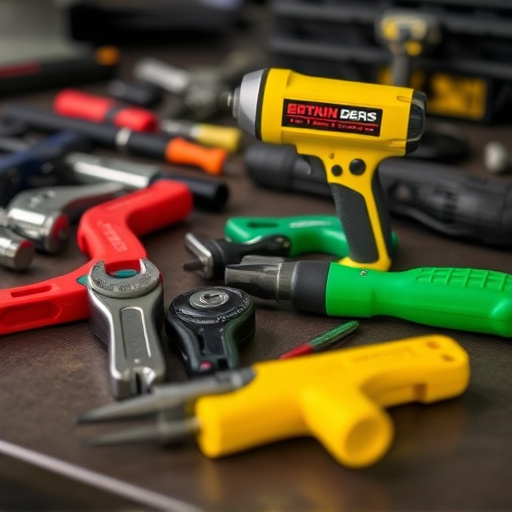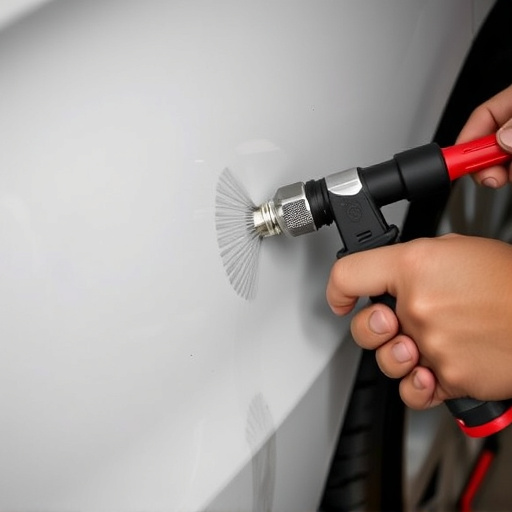The Tesla Body Computer (TBC) is a key component that manages various vehicle functions. Glitches or communication issues can arise, necessitating a reset to clear corrupted data and faulty programming. This 5-step process involves powering off, locating the reset button, holding it for 10 seconds, releasing it, waiting, reconnecting devices, and starting the Tesla. Regular resets enhance overall performance and system integrity, similar to routine auto body service for internal technology.
Uncover the secrets behind your Tesla’s smooth operation with a focus on its critical component—the body computer. This powerful system acts as the car’s neural network, facilitating seamless communication across various functions. However, issues can arise, leading to performance hiccups. One effective solution is a simple yet potent reset, ensuring optimal connectivity. This comprehensive guide breaks down the process step-by-step, empowering Tesla owners to independently restore their vehicle’s peak performance through a Tesla body computer reset.
- Understanding Tesla's Body Computer and its Role in System Communication
- Why Resetting the Tesla Body Computer is Necessary for Effective Communication
- Step-by-Step Guide to Performing a Tesla Body Computer Reset
Understanding Tesla's Body Computer and its Role in System Communication

Every Tesla vehicle comes equipped with a sophisticated computing system known as the Tesla Body Computer (TBC), which plays a pivotal role in facilitating seamless communication between various components within the car. This advanced technology acts as the brain of the vehicle, managing and coordinating functions ranging from navigation and infotainment to safety features and vehicle dynamics. A malfunction or miscommunication in this intricate network can lead to issues affecting the overall performance and efficiency of your Tesla.
When troubleshooting problems related to system communication, performing a Tesla body computer reset emerges as a crucial step. This process involves resetting the TBC to its default settings, essentially erasing and rebuilding the software connection. It’s akin to restoring a car to its original state after repairs or damage repair at an auto body shop. By doing so, any corrupted data or faulty programming can be eliminated, allowing for optimal system communication.
Why Resetting the Tesla Body Computer is Necessary for Effective Communication

In today’s digital age, effective communication within a Tesla vehicle is paramount for its optimal performance and safety features. The Tesla Body Computer, a sophisticated on-board system, acts as the brain that coordinates various functions, from navigation to collision response. Over time, or due to unexpected events like accidents (requiring services from a collision repair shop), this computer can experience glitches or miscommunications. A reset becomes necessary to rejuvenate its performance and ensure seamless interaction between its numerous components, much like how a car body restoration revitalizes a vehicle’s exterior.
Resetting the Tesla Body Computer is akin to giving it a digital fresh start, clearing any faulty data and re-establishing proper communication pathways. This process is crucial in maintaining the integrity of the vehicle’s systems, especially critical safety features. Regular resets can help prevent more serious issues that might arise from persistent communication errors, ensuring your Tesla operates at its best. Think of it as a routine auto body service for your car’s internal technology.
Step-by-Step Guide to Performing a Tesla Body Computer Reset

Performing a Tesla Body Computer Reset is a straightforward process that can resolve various system communication issues within your Tesla vehicle. Here’s a step-by-step guide to help you through it:
1. Power Off and Disconnect: First, ensure your Tesla is powered off and disconnected from any external power sources. This includes removing the key fob from the ignition and disconnecting any diagnostic tools that might be connected.
2. Access the Reset Button: Locate the reset button typically found under the steering wheel or within the vehicle’s control panel. Some models may have it hidden behind a panel, so refer to your owner’s manual if needed. For a smooth vehicle body repair and car restoration, this step is crucial as it initiates the reset process.
3. Perform the Reset: Press and hold the reset button for at least 10 seconds. You may need to consult your vehicle’s manual for specific instructions, as some models might require additional steps or a slightly different sequence. This action will trigger a system-wide reset, clearing any temporary glitches or errors.
4. Wait for Completion: Release the button and allow the process to finish. During this time, you may notice various systems in your Tesla restarting, which is normal. Once complete, you should see the dashboard indicators reset to their default states.
5. Re-establish Connections: After the reset, reconnect any diagnostic tools or devices you previously detached. Then, insert the key fob and start your Tesla to ensure all systems are functioning optimally. This step ensures a seamless driving experience after your auto repair services.
Resetting the Tesla body computer is a crucial step in ensuring optimal system communication. By following a simple, yet effective, guide, owners can resolve potential issues and enhance their vehicle’s overall performance. This process allows for a fresh start, eliminating any glitches or errors that may have arisen over time. Remember, regular maintenance, including occasional resets, is key to keeping your Tesla running smoothly.












